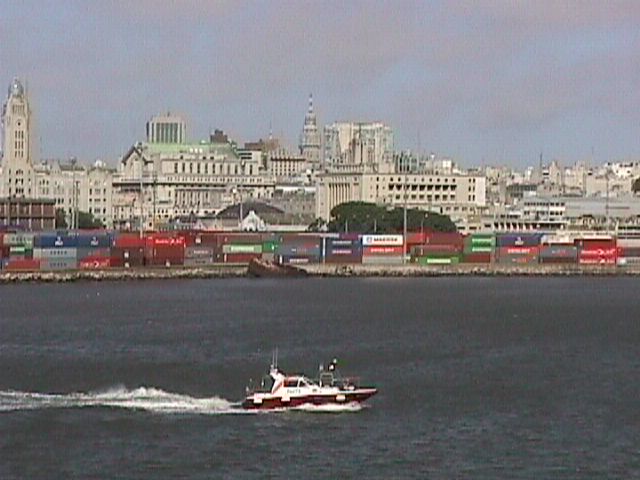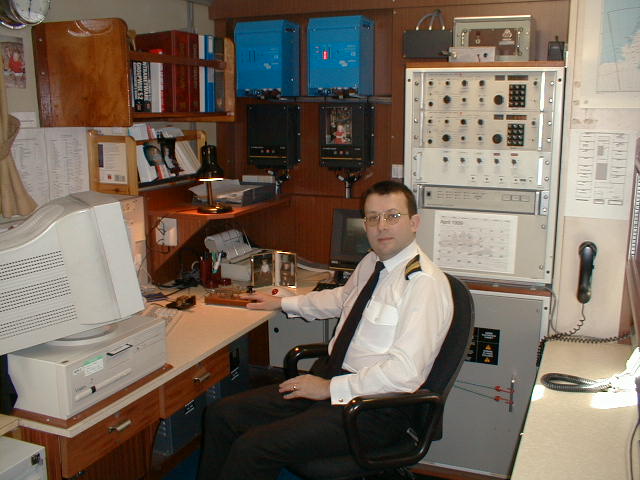| Date | Sunday 11th April 1999 |
| Time | 1200 (UTC-3) |
| Position | Latitude 34°54' South
Longitude 056°12' West Deposito 2, Montivideo |
| Next destination | Grimsby |
| ETA | 6th May 1999 @ 0846UTC |
| Total distance | 25583.0 Nautical Miles
(Since departing Grimsby on 17th October 1998) |
| Current weather | Overcast |
| Wind | Light |
| Sea state | N/A |
| Air temperature | 19.4°C |
| Sea temperature | 19.9°C |
Ship's
track - Updated every six hours from the weather observations sent
to Bracknell weather centre - direct from BAS
homepage.
Summary
Monday saw a slight improvement in our weather and it was thought that we would start to enjoy a calmer sea, but alas that was not to be and by Tuesday afternoon the swell had increased and the ship was once again rolling. In the early evening we altered course to enable a slightly smoother passage. A slide show was held in the FIDS bar, with Vicky Auld talking about winter life at Halley followed by Ritchie Robinson telling us about Rothera. There was no great improvement in the weather on Tuesday, with the wind up to Force 7 at times during the day.
On Wednesday a group of Pilot whales were spotted, almost surfing the crests of the waves. In the evening a quiz night was held in the FIDS bar. The wind had dropped to a Force 4 and there were signs of better weather on the way.
Thursday and the Bransfield was now in ship infested waters! After so long away from shipping lanes there is always a great interest when other ships are in the vicinity and today was a good day for ship watching. On the bird front an Egret joined us for a short while in the afternoon. Thursday evening saw several of the Officers enjoying 'sundowners', having a drink out on deck and watching the sun set.
Friday morning came with flat calm seas and only a few hours steaming
until Montevideo was reached. The pilot joined the ship at 1500 and guided
us into port and the ship was secure alongside Deposito 2 by 1630. The
four FIDS who had left the ship in Stanley to travel around southern Chile
were waiting on the docks for us, having had a very good time.
Montevideo
Montevideo is the capital city of Uruguay, a country that is about
the same size as England and Wales, and was founded in 1726. It is a cosmopolitan
city that now boasts a number of large modern shopping centres. The Avenida
18 de Julio is the main shopping street in the city and is always busy.
Driving in Montevideo can be somewhat unnerving and is not recommended
to the faint hearted. There is a very good bus service around the town
and also for longer journeys into the country. The city is full of small
bars and cafes, a number with seats on the pavement, and one way to relax
is to sit outside with a drink and just watch the world go by. There is
a very good nightlife in Montevideo and many of the bars don't shut until
the very early hours of the morning. In general the city is a safe place
and as long as you don't wander around some of the less favourable areas
on your own in the middle of the night there is nothing to fear.
The large attraction of Montevideo is, almost certainly, its food. There are so many restaurants to choose from, nearly all of them are excellent, and the price of a good meal with drinks is relatively inexpensive. For the price of a burger and chips from one of the rapidly expanding fast food outlets in the city, you could enjoy a prime piece of fillet steak! Generally the Uruguayans eat much later than Europeans, dinner tending to be between 2100 to 2400. Beef is eaten almost at all meals, it is of excellent quality and in many places it is grilled. One style of food is the Asado, this is a barbeque style of cooking that utilises an interesting method. One end of the barbeque has a large fire, using one of three types of wood which produces embers that burn for a long time, and these embers are dragged under the barbeque section, onto which all the meat is cooked. Asado means barbequed beef, and ribs, fillet steak and entrecot are all available, along with nearly every other part of the animal that can be cooked. Pork, chicken and fish are also cooked in this way. Salads tend to be large (I don't think I have ever seen a small portion of anything in the many visits to the city's restaurants over the years). Sausages, which tend to be more expensive than basic meat are also popular, often eaten as a starter. Known as chorizos, morcillas and salchichas. Deserts are, like all the other food, delicious - and often large!. Montevideo is not a good place to go if on a diet! There are now several vegetarian restaurants springing up in the city and a salad can easily be a meal in itself.
Leather shops abound in Montevideo and when the ship docks there are always representatives from several of the better know shops waiting for us, giving out leaflets with details of their shops to all on board. Often they will drive a group of people into the city to look around the shop, offering a beer or coffee as an incentive to get customers. Leather goods used to be an excellent bargain in the past, although the prices now are creeping up.
For those that want the ultimate in pampering, a visit to one of the upmarket barber shops is a must. For the price of a good haircut in the UK you can expect a cut, shave, facial massage and a manicure. The whole process can take up to ninety minutes and is so relaxing that it would be easy to fall asleep in the barbers chair.
Sunday afternoon saw a group from the ship set off, on buses provided
by the local leather shops, to see the top of the table local football
derby. A crowd of 40,000 plus is expected to be at the game. Fireworks,
entertainment and noise will reach a crescendo as kick-off approaches and
continues throughout the match. Depending on the result one half of the
city will be celebrating while the other half mourns. Spotting the difference
is extremely difficult! The spectators from the ship will not mind either
way.

Satellite communications, using a terminal connected to a rotatable dish mounted high up on the ship, is not new and has allowed the use of telephone, fax and telex traffic. In 1990 when Mike started with BAS nearly all communications with Cambridge (the site in the UK of the British Antarctic Survey) were by fax. Due to the high cost of satellite air time (about $8/minute) the volume of traffic was low with only essential messages being sent. By the mid 1990's electronic mail had started to appear on the scene and a system was developed whereby messages could be typed up and sent off electronically. This alone increased the volume of traffic both sent and received by the ship, although the processing of the messages was fairly slow still and the messages would be printed out and then delivered by hand to the recipient. In the past two to three years the ships and bases have had their Inmarsat terminals upgraded to the latest digital systems that also, as well as phone, fax and telex, offer a high speed data link (at 56kbs) and this has opened the floodgates to communication. For the price of several sheets of fax messages sent in 1990 it is now possible to send and receive mail messages for everyone on board. The e-mail is still not cheap and so the sending of large attachments (pictures, sound etc) is generally not allowed for personal use, but for work related items it is a boon. If it were not for this system these web pages and the images taken using a digital camera (yet another advancement that we now wonder how we survived without) would not be available. The worst fear of many on board is a problem with the e-mail system as so many now depend on it for a regular and reliable means of keeping in touch with family back home. The cost of making a phone call has also dropped dramatically from the $8/min in 1993 to as low as $2.20/min today.
There are still other means of communication available, depending on the circumstances. The ship is fitted with two 800w HF (high frequency) SSB (single side band) transceivers and with this it is possible to communicate world wide. They are generally used whilst the ship is in the southern ocean for talking with the bases and ships that will be visited or seen. Associated with this is a telex system for sending messages. The advantage of both these systems is that there is no cost for their use. For communicating at closer range (within fifteen miles or so) there are numerous VHF (very high frequency) radios fitted and these tend to be used most during cargo operations with a base. Should the need arise to talk with aircraft (sometimes this occurs whilst on route to Halley and ice observations are required) an aero-nautical VHF set is also fitted.
There are two general purpose receivers fitted in the Radio Room, clearly seen in the picture above, and these tend to be used to receive the BBC World Service or if in the vicinity of the Falklands the local broadcast from there. It is possible to broadcast this around the vessel, thus no one on board needs to have expensive short wave radios to listen to the latest world news.
The morse key is still used by Mike on the amateur bands, when time
allows, and in this way he keeps in contact with many friends in the UK
throughout the season. For the really observant of you, the bungee cord
is used in rough weather to try and stop the chair from moving around too
much!

Lunch on Monday at the Meat Market, just outside the docks then sail at 1600 for Grimsby. As the ship heads for Grimsby the clocks will have to be advanced four hours from UTC-3 to BST
GM0HCQ/MM QRV 14052kHz @ 2000z & 0000z and 21052kHz @1500z
The next update will be written on Sunday 18th April 1999 and should
be published on Monday 19th April 1999.
